State of the Union: Seagate's HAMR Hard Drives, Dual-Actuator Mach2, and 24 TB HDDs on Track
by Anton Shilov on February 7, 2019 2:00 PM EST- Posted in
- HDDs
- Storage
- Seagate
- Helium HDD
- HAMR
- Dual Actuator HDD
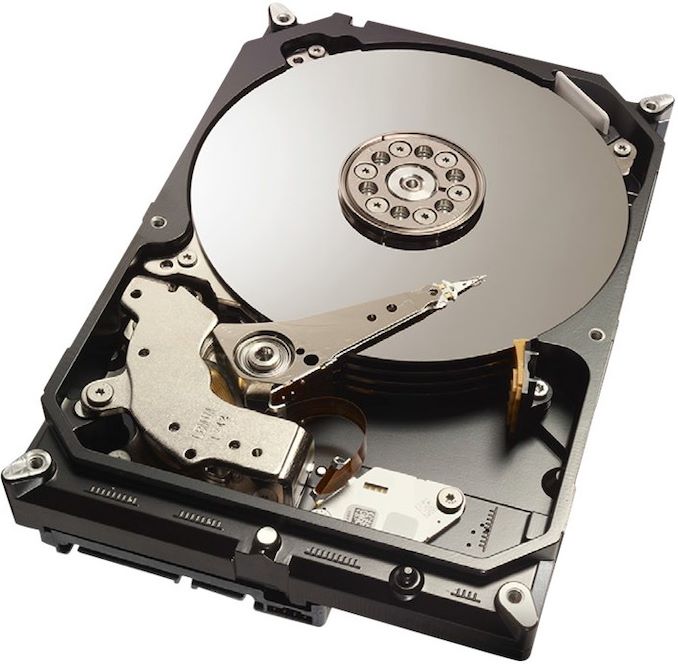
Seagate this week reiterated that the company is on track to launch two crucially important technologies later this calendar year. Firstly, the company plans to start ramping up its 16 TB hard drives featuring heat-assisted magnetic recording (HAMR) technology in 1H 2019. Secondly, the manufacturer intends to launch its first 14 TB HDDs featuring two actuators, up to 500 MB/s sequential read speed, and up to 160 IOPS later this year. Also, the company has stated that it is already testing its next iteration of HAMR that will enable hard drives with capacities up to 24 TB.
Table of Contents
- Need for Storage
- HAMR: Nearly Here
- 24 TB HDDs En Route
- Dual Actuator HDDs Ready for Prime Time
- First Multi-Actuator HDD: 14 TB, ~480 MB/s
- Final Thoughts
| Seagate's Datacenter and Exascale HDD Plans | |||||
| AnandTech.com | H1 2019 | H2 2019* | 2020 | ||
| Capacity | 16 TB | 14 TB | ~20+ TB | 16 ~ 20 TB | |
| Recording Technology | HAMR | PMR | HAMR | ||
| Performance | Over 250 MB/s ~80 IOPS 5 IOPS/TB |
~480 MB/s ~160 IOPS ~11 IOPS/TB |
? ~80 IOPS 4 IOPS/TB |
? | |
| Actuators | Single Actuator | Dual Actuator | Single Actuator | Dual Actuator* | |
| Notes: | *Not confirmed formally | ||||
Need for Storage
The market of hard drives is shrinking in terms of unit sales, but continues to thrive in terms of total capacity shipped as well as revenue. There may be some exceptions (e.g., Q4 CY2018), but the general trend is here. Unit shipments drop because modern laptops cannot accommodate a large 2.5-inch mechanical hard drive, whereas desktops can suffice with just one high-capacity Barracuda Pro-like storage device. What actually drives revenues in modern times are enterprise and exascale cloud datacenter-oriented HDDs that are used to enable services like Azure, Facebook, Gmail, iCloud, Netflix, Prime, and this is just to name a few.
Needless to say, that hard drives aimed at Apple, Facebook, Google, Netflix, Microsoft, and others are the first models to accommodate the latest technologies developed by Seagate (and other manufacturers), which is why it makes sense to pay a close attention to the company’s plans for datacenter HDDs in a bid to understand where the technology is going in general. Some of technologies found in such drives will eventually migrate to consumer HDDs.
HAMR: Nearly Here
HAMR (Heat Assisted Magnetic Recording) is something that Seagate has been working on for over a decade and this year it will finally hit mass production. Among other things, the HAMR technology posed two major challenges that Seagate had to solve. The first one is media itself that can handle a 450°C local heat (made using a laser with an 810 nm wavelength and a 20 mW power) without degrading over time. The second one is a writer with a near-field optical transducer (NFT) that heats the media and which also has to work without flaws for up to a decade or longer. Seagate has developed appropriate media and its writers can handle up to 4 PB per head data transfers, which is more than sufficient for modern enterprise/datacenter HDDs (that are rated for a 550 TB workload a year). In fact, the company says that not only its internally developed media and heads for HAMR HDDs meet datacenter requirements, but so do components designed externally as well.
Seagate officially started to ship its fully functional single-actuator Exos 16 TB HAMR-enabled helium-filled HDDs to select global hyperscale and OEM partners in early December for demonstration purposes. These drives are drop in compatible with existing server infrastructure and power consumption per unit does not exceed 12 Watts. In fact, it is in line with power consumption with other helium-filled HDDs since NFTs do not consume a lot of power at all.
Earlier this week Dave Mosley, CEO of Seagate, said that the company’s HAMR drives will be launched commercially in the first half of this year and will ramp after its partners validate them.
24 TB HDDs En Route
While Seagate is gearing up to launch its Exos 16 TB HDDs officially in the coming weeks or months, the company promises that its HAMR technology will enable it to release hard drives featuring ~18 TB ~ 20 TB or even higher capacities sometime next year. Furthermore, Seagate has already tested tech that will be used for 24 TB HDDs.
Late last year the company said that it had successfully demonstrated platters featuring a 2.381 Tb/in2 (Terabits per square inch) areal density in spinstand testing, which basically means a drive without an enclosure on a test bed. This areal density enables Seagate to make 3.5-inch platters with a 3 TB capacity. Eight of such disks can be used to build a 24 TB HDD. When it comes to longer-term future, Seagate once said that it had developed media with up to 10 Tb/in2 areal density in the lab.
Dual Actuator HDDs Ready for Prime Time
Another of Seagate’s technology that made headlines last year was the company’s Multi-Actuator Technology (MAT) designed to improve sequential and random read and random write performance of hard drives. On a high level, MAT improves MB/s and IOPS performance of HDDs, but a deeper look quickly reveals that this tech is crucial for the upcoming generations of datacenter hard drives in general and not only because of pure performance numbers.
It is well known that operators of exascale datacenters keep power consumption of servers and individual components in check because they can supply a relatively finite amount of power and remove a limited amount of thermal energy. It is also known that the majority of cloud datacenters use SSDs for frequently accessed data and nearline (near online) HDDs to store data that is accessed a bit less regularly. SSDs enable operators of the said datacenters to provide certain services instantly, but even when they need to access data from hard drives, there is a strict standard when it comes to time they need to access their data within their datacenter.
In general, today’s 3.5-inch HDDs offer random performance of 6 – 10 IOPS per terabyte, which is sufficient for contemporary datacenters and is enough to ensure their quality-of-service requirements. Meanwhile, as hard drives gain capacity, their random performance per terabyte drops and once it drops below 5 IOPS per TB (which is believed to be the lowest target for many modern datacenters), such HDDs will no longer meet service level agreement and therefore QoS requirements. Consequently, operators who do not meet their IOPS per TB requirements (whether these are 4, 5, or 7 IOPS per TB) need to either reduce the amount of capacity they use per drive (i.e., buy smaller drives, or pay for capacity they cannot use), or demand drives that offer a higher I/O performance. This was explained Jason Feist, Seagate’s Director of Technology Strategy and Product Planning who is responsible for the company’s datacenter product roadmap.
At present, Seagate can tune hard drives to deliver I/O that its customers require by implementing command queuing and latency-bounded I/O (LBIO) in firmware (i.e., lower performance), but at some point, these methods will cease to work efficiently. In particular Seagate says that at ~16 TB and beyond more and more customers (but not all of them) will need HDDs that could physically feature a higher I/O performance.
To improve I/O performance of next-generation hard drives, both Seagate and Western Digital plan to install two (or more) sets of actuators into a single HDD. The actuators are to be outfitted with their own arms/heads as well as magnets to position them, but will use one pivot. Therefore, the actuators will work autonomously, basically producing parallelism within a single HDD. As hard drives gain ability to read or write with more than one head at any given time, their random read/write performance will scale with the number of actuators. Sequential read/write performance of HDDs will also increase all the way to 480 MB/s (in case of the first-gen MAT-enabled HDDs), but as it will depend on numerous factors, it is hard to make predictions about throughput of next-gen hard drives.
The extra components needed for two independent actuator assemblies (and a considerably more sophisticated HDD controller) will make such HDDs a bit costlier to manufacture when compared to today’s models. This is a reason why going forward Seagate will have at least two lineups of HDDs for hyperscale workloads: one guaranteeing optimal IOPS per TB with multiple actuators and another guaranteeing minimum IOPS per TB and aimed at customers who can manage required performance levels.
First Multi-Actuator HDD: 14 TB, ~480 MB/s
Seagate’s first-generation MAT-enabled HDDs, dubbed Mach2, use two actuators operating on a single pivot point (along with 8 platters and 16 heads). These drives are set to feature a 14 TB capacity, 480 ~ 500 MB/s sequential read/write performance, as well as up to 160 IOPS. What is not completely clear is how much power will these HDDs consume, as the only thing that Seagate says is that they will consume significantly less than two HDDs. The key thing here is that the drives will still be drop-in compatible with 3.5-inch bays, which is the most important thing for operators of exascale datacenters.
Seagate says that it had supplied prototypes of its Mach2 HDDs to its partners and such drives had been used for “live production traffic” for months now. Their volume ramp will begin later this calendar year, yet Seagate does not elaborate.
Final Thoughts
With plans to launch two crucially important technologies in 2019, this year will be fundamentally important for Seagate. The company is ahead of its rivals with its HAMR and multi-actuator technologies, but now it needs to execute and deliver appropriate HDDs to interested parties. Next year will also be important for Seagate as it will have to bring together its HAMR and multi-actuator technologies and offer rather unique drives to its customers.
As noted above, many technologies originally developed for enterprise and exascale datacenter hard drives usually migrate to HDDs aimed at high-end desktops, workstations, and NAS. Obviously, both HAMR and MAT make a great sense for all of the aforementioned applications, but it remains to be seen which of the technologies will be used for “civil” PCs and storage devices first.
Related Reading
- Seagate Starts to Test 16 TB HAMR Hard Drives
- Seagate’s Multi Actuator Technology to Address HDD IOPS Woes
- The Evolution of HDDs in the Near Future: Speaking with Seagate CTO, Mark Re
- 16 TB MAMR Hard Drives in 2019: Western Digital
Source: Seagate


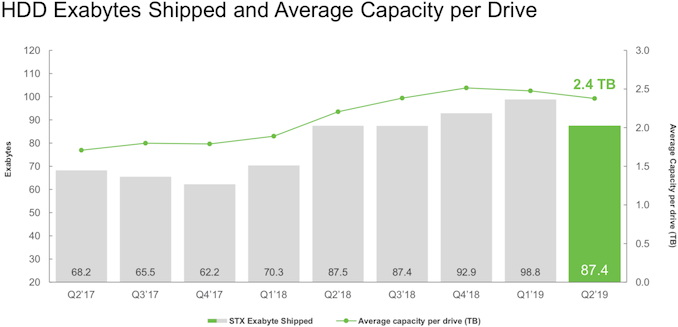

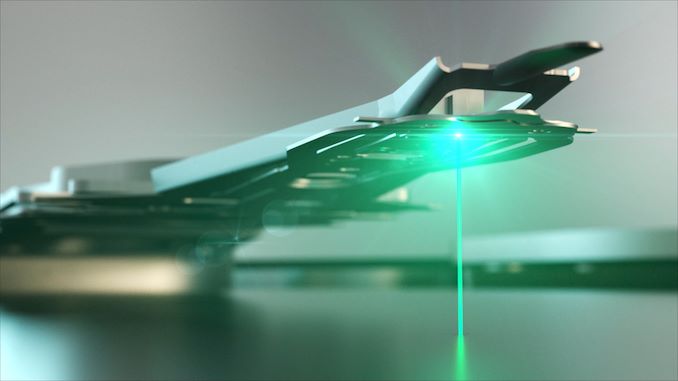

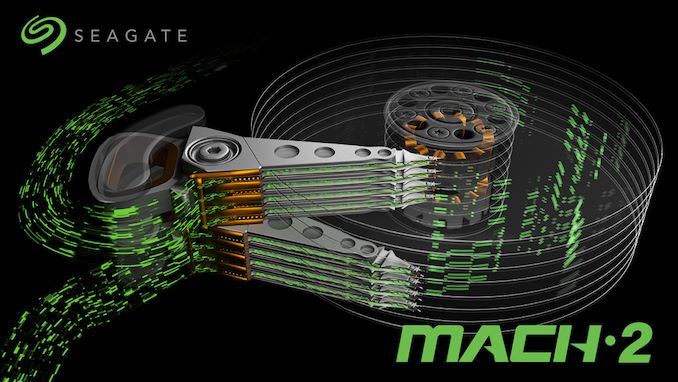
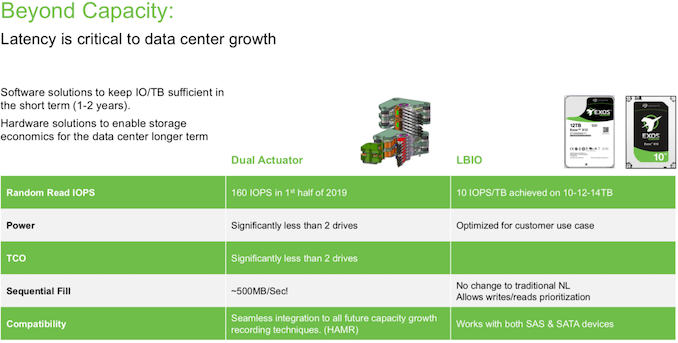









54 Comments
View All Comments
rahvin - Friday, February 8, 2019 - link
The HDD market is actually bigger than it was when the laptop HDD market still existed. The arise of the cloud and the massive storage arrays that it's generated has put HDD revenues at record levels even with the loss of significant prior market share.But it quite amazing how much it's changed over the last ten years. in 2008 the average HDD was a single platter and they couldn't imagine disks with 4 or more platters and now we've moved towards 8 platters as they try to drive up density without any associated increase in technology because as you say they've hit the physical limits of magnetic recording and the only way to increase platter density at this point is exotic techniques like heating up the platter to allow smaller writes all while they keep adding more and more platters to disks.
It's frankly going to be interesting to watch the machinations they go through to continue to drive density on the 3.5 drive up as the cloud demand for storage is growing almost exponentially. The cloud companies are willing to pay buckets of money to drive up density so they can drive down overall storage costs. Given the physical limitations they've hit with magnetic storage they are now trying things they wouldn't have even considered a decade ago. Helium filled drives are just plain crazy. HAMR and MAMR are even crazier. But it will certainly be interesting, that's for sure.
DanNeely - Friday, February 8, 2019 - link
They're growing in dollar terms, but are down nearly half in number of drives shipped from their 2011 peak. That is leading to them shutting down some of their manufacturing sites (as detailed in some previous pipeline articles).https://www.statista.com/statistics/275336/global-...
Your claim about 4 platter drives being unimaginable a decade ago just isn't true. I've been dismembering all the dead drives I've bought over the last 15 years; and the ones that were big when new were all 4/5 platter types. At the time max tech platters had little cost premium so small drives were only 1 or 2 platters; but big ones were always a near/full stack.
HAMR/MAMR were both supposed to be out several years ago. Unexpected difficulties in getting them to production is a big part of why they've missed predicted future TB/drive levels so badly.
rahvin - Friday, February 8, 2019 - link
I might be off a half a decade in my timeline. I've been disassembling a bunch of old drives the last week or two to extract magnets and other fun things, most of them are 1 or 2 platter at the most. But all the drives are sub-terrabyte so like I say I'm probably off a few years. I do distinctly remember when all drives were a single platter, and honestly it wasn't that long ago, at least to me.Part of the reason HAMR/MAMR are so late is just how crazy this tech is. Your talking about micro-heating the platter right under the super tiny head while the disk is moving by at 7200rpm. This is just insane, the level of control need for this is crazy difficult (and you have a very small window of temperature where it works, if it's too hot you wipe out adjacent data and if it's not hot enough you can't write). It's a massive addition to what mechanically was a pretty simple system prior to this. The level of precision needed is probably right up there with nuclear time triggers. It doesn't surprise me at all that it's taken this long to get it reliable (if it actually is reliable, I guess we'll all find out).
Lord of the Bored - Friday, February 8, 2019 - link
Physics. Harder to spin up and keep at speed. And wider platters can't be spun as fast.DanNeely - Friday, February 8, 2019 - link
The real killer with 5.25" HDDs (which were a thing into the 90s) was that the double platter radius meant a doubled average seek time; which absolutely clobbered performance.wumpus - Friday, February 8, 2019 - link
Really? I'm guessing the "elevator algorithm" was still applicable (keep seeking the nearest sector in one direction until there aren't any more, then reverse direction), so it could require the actuator to move further. I'll also have to admit that the 3.5" drive probably had a lot to do with making the elevator algorithm obsolete.Don't forget that for a lot of the 1980s, "full height drives" were twice the height of a "modern" 5.25" bay. Such a drive (with a bunch of platters with presumably easier clearance) might make sense on it's own now, but nobody wants to alter the existing infrastructure for such small gains (you could eat the latency for the extra storage, but you don't want to redesign all the cases, NAS devices, rack equipment, etc...).
twotwotwo - Thursday, February 7, 2019 - link
Hadn't thought about how it would become hard to use higher capacities without higher IOPS at some point. Interesting.Darcey R. Epperly - Friday, February 8, 2019 - link
Where are the 100TB drives promised in 2010?Supercell99 - Friday, February 8, 2019 - link
they have them developed, but they are milking the $/TB price curve for another decadedanwat1234 - Friday, February 8, 2019 - link
So, when will 4TB 2.5" 9.5mm laptop drives come out?